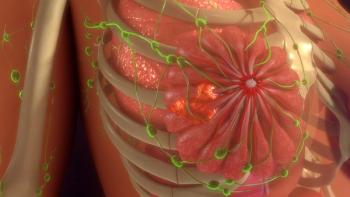
The Exciting Present and Future of Kidney Cancer Care
The treatment paradigm in renal cell carcinoma (RCC) has expanded over recent months to include three practice-changing agents in the second-line setting.
Patients with renal cell carcinoma (RCC) have more treatment options than ever, as the three practice-changing agents were recently approved in the second-line setting: Opdivo (nivolumab), Cabometyx (cabozantinib) and the combination of Lenvima (lenvatinib) and Afinitor (everolimus).
Most recently, the FDA approved the two-drug regimen of Lenvima and Afinitor in May 2016 for patients with advanced RCC who previously received antiangiogenic therapy. Cabometyx, a multikinase inhibitor, was approved by the FDA in April 2016 for the same indication.
Additionally, the FDA approved the PD-1 inhibitor Opdivo in November 2015 as a treatment for patients with metastatic disease following prior antiangiogenic therapy.
“We now have three therapies that have raised the bar and therapies that have shown, for the first time ever, that we could impact survival in patients with kidney cancer,” says Thomas E. Hutson.
Researchers are still investigating the full potential of each of these agents and exploring them in combination with other immune-based and targeted therapies in other settings, he adds.
For example, frontline treatment with Cabometyx has been shown to significantly improve progression-free survival (PFS) in patients with advanced disease in the phase 2 CABOSUN trial; full results of the study will be presented at an upcoming medical meeting.
In an interview with CURE, Hutson, director of the Genitourinary Oncology Program, Charles A. Sammons Cancer Center at Baylor University Medical Center, discusses how these three agents have significantly impacted the management of patients with RCC and promising combination regimens on the horizon to propel the field forward.
There have been some exciting advancements in this field recently. Can you speak to how far we have come and where we are going?
Certainly, in the past five years, we have come a long way. In the last 10 years, we went from having no proven therapy that would work in the majority of folks, to now having eight therapies in the past five years. The biggest issue is that, in the past six months, we have approved three new therapies. That has been the change.
For the most part, we did not have therapies that could prolong survival that we could show in a clinical trial. All of the therapies we had approved were based on a PFS endpoint. With Opdivo, Cabometyx and Lenvima, we have now three data sets that show that patients who get those therapies have PFS advantages in regards to Cabometyx and Lenvima, have objective tumor response benefits with all three, and have an overall survival benefit with all three. That has been a major advance.
Since this just happened in the last six months, it is going to take time for us to sort through that data and try to figure out how we are going to best utilize these agents in our patients. However, I can rest assured that all three of these agents have a role to play in our patient management.
We will need to figure out what the ideal strategy is in the various treatment settings. However, across the board in cancer, we have learned that one strategy doesn’t fit for all. Some patients will receive one agent ahead of the other, based upon the unique characteristics of the individual patient and the unique characteristics of the patient’s tumor.
Looking at the newest agents available in this space, are there side effects associated with them that play a factor in choosing one over the other?
Where we are going with tumor profiling, molecular profiling and biomarkers is still evolving, so there is nothing ready yet for prime time. However, we anxiously await future data sets that will help us. A lot of things have happened very quickly and the paradigm for the management of kidney cancer has changed over the past six months. We will have to wait and see how key opinion leaders are dissecting the data to determine exactly how we are best going to utilize it.Potentially, but we have done this long enough and we are smart enough about it that, if you actually take the side effects of each of the drugs that we have and put them next to each other, you find such slight differences in percentages—shades of gray, if you will.
We are also smart enough to know that, just because one drug has 5 percent less of a side effect, it really matters what the patient in front of you experiences. Over the past decade, we have learned that patients are going to have their own unique tolerability. I don’t see any major side effects of any of the drugs that we have that would necessarily preclude in that particular patient population. You almost have to individualize it to that unique patient’s set of comorbidities.
Some details have been released regarding the CABOSUN trial, which is examining frontline Cabometyx in patients with RCC. What can you share about these results?
You would want to avoid an mTOR inhibitor in someone who is a fragile diabetic. If someone had an autoimmune disease, such as rheumatoid arthritis, you would give pause to using an immune-based therapy. It would be that kind of high-level discussion. One patient could have one side effect that the next patient doesn’t have. The humor in it is that you can really sit and look at the toxicity profile of the drugs and find that they all overlap. There is not enough difference to really choose one over the other, in my opinion.All I can comment on is what is stated in the press release because of confidential disclosure agreements. I can also comment on what Dr Toni Choueiri has commented from that press release, which is that this opens doors for a potential role of Cabometyx to be a primary frontline therapy.
The Lenvima/Afinitor combination has shown exciting activity. What other combination regimens on the horizon are you anticipating?
In the RCC community, we certainly welcome advances in therapy. This may, too, prove that this is a major therapeutic improvement for our patients; however, as is noted in the press release, the actual data—the nuts and bolts of the data—have not yet been released. We won’t have that data formally presented for the general community to dissect and comment on it until a later meeting, and that may be several months from now.Cabometyx is certainly being studied in a variety of combination trials that are too early to comment on but, naturally, it is being combined with immuno-oncology drugs. There are major frontline trials that have completed enrollment. One is the combination of Yervoy (ipilimumab) and Opdivo versus Sutent (sunitinib). There is also a trial of Tecentriq (atezolizumab) combined with Avastin (bevacizumab) versus Sutent. Both of these were phase 3 international trials in the frontline setting. We’ll have to wait and see what those results show.
Currently, we are enrolling two trials of Opdivo combined with Inlyta (axitinib) versus Sutent. All of those combination strategies combine TKIs with an immunotherapy agent, or combine two immunotherapy drugs. There is great hope for that potential improvement in therapy.
Certainly, the phase 2 CABOSUN data is going to have to be dissected out and understood in how it compares against a phase 3 trial. It is all going to have to play out, and I think we will have answers to these big questions over the next six months to one year.





